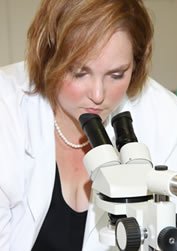'Bloodstain Pattern Analysis' course affirms SU's status as forensics leader
SU is one of only two universities in the country to offer an IABPA-approved course

A course in bloodstain pattern analysis, offered by Syracuse University’s College of Arts and Sciences, has been recently approved by the International Association of Bloodstain Pattern Analysts (IABPA). SU is one of only two institutions in the country—the other is Baylor University in Texas—to offer a course sanctioned by IABPA, which is responsible for promoting the education of all involved with bloodstain pattern analysis.
SU’s course, “Bloodstain Pattern Analysis” (FSC 463/663), is taught by Anita Zannin G’11 in the Forensic and National Security Sciences Institute (FNSSI).
“Successful completion of this course fulfills the minimum guidelines and criteria for provisional membership in the IABPA,” says Zannin, a consultant for the Syracuse-based AZ Forensic Associates. “Membership in professional organizations is critical for anyone wishing to enter or get ahead in forensic science or one of its many allied fields. There are many networking, educational, and courtroom benefits."

“It’s another reason FNSSI is in a class by itself,” he says. “In addition to being the only university on the East Coast to offer IABPA-approved curriculum, we are home to the nation’s only program focusing on the scientific interface between forensic and national security sciences.”
Krystyna Rotella ’10, a Madison County (N.Y.) deputy sheriff, recommends "Bloodstain Pattern Analysis" to anyone looking to get ahead in forensics or law enforcement. “We tested theories of blood patterns in real-life situations,” says Rotella, recalling her time in the course. “I gained a wealth of knowledge that I will use in law enforcement and, eventually, in criminal forensics. It was a blast.”
“Bloodstain Pattern Analysis” provides a hands-on, interdisciplinary approach to the science of bloodstains. Much of the curriculum delves into the history, theory, and scientific principles behind such analysis methods.
“We put considerable emphasis on experiments and practical application,” says Zannin, who also has an extensive medical background. “Students use bloodstains to reconstruct incidents, such as assaults and death investigations, and to evaluate statements from witnesses and crime participants.”
In addition to traditional students, “Bloodstain Pattern Analysis” is offered as an affordable non-credit option to mid-career professionals in forensic science, law, health, or medicine.
“Our format places less burden on police departments and labs, all of which have strained budgets during this difficult time,” says Zannin. “With us, they don’t lose employees to days or weeks of training—something that, along with the cost of transportation, tuition, lodging, and meals, can add up to thousands of dollars.”
Adds Spencer: “This course is a great way to strengthen our ties with the regional law enforcement and forensic science communities.”
FNSSI provides broad, interdisciplinary scientific research and theory to real-world legal and security issues. In addition to multiple graduate and undergraduate opportunities, FNSSI is home to a new state-of-the-art laboratory suite, dedicated to the study of bioforensics and combustible materials.
Media Contact
Rob Enslin
